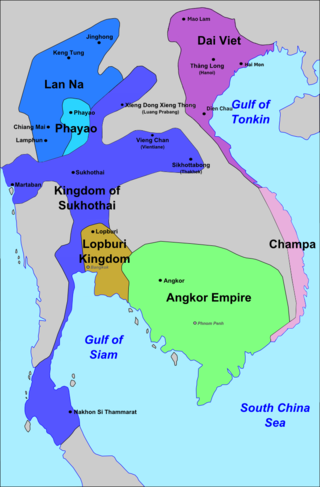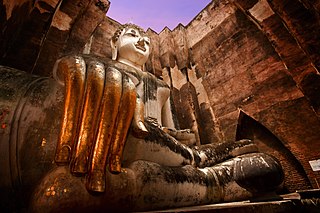
The Sukhothai Kingdom was a post-classical Siamese kingdom (maṇḍala) in Mainland Southeast Asia surrounding the ancient capital city of Sukhothai in present-day north-central Thailand. It evolved from a trading hub to a city-state in 1127 and emerged into the kingdom by Si Inthrathit in 1238. Sukhothai existed as an independent polity until 1438 when it fell under the influence of the neighboring Ayutthaya after the death of Borommapan.

Sukhothai Historical Park covers the ruins of Sukhothai, literally 'dawn of happiness', capital of the Sukhothai Kingdom in the 13th and 14th centuries, in north central Thailand. It is near the city of Sukhothai, capital of Sukhothai Province.

Ramkhamhaeng or Pho Khun Ramkhamhaeng Maharat was the third king of the Phra Ruang Dynasty, ruling the Sukhothai Kingdom from 1279 to 1298, during its most prosperous era.

Thai art refers to a diverse range of art forms created in Thailand from prehistoric times to the present day, including architecture, sculpture, painting, textiles, decorative arts, crafts, ceramics, and more. While Buddhism has played a significant role in Thai art, with many sculptures and paintings depicting Buddha images and religious themes, nature, including flora and fauna, as well as mythical creatures, has been a major inspiration for Thai art, with colorful motifs appearing in various types of art forms. In contemporary Thai art, traditional works remain significant and continue to influence artists' concepts.

The Bang Pakong is a river in east Thailand. The river originates at the confluence of the Phra Prong River and the Hanuman River near Kabin Buri, Prachinburi Province. It empties after 231 kilometres into the Gulf of Thailand at the northeastern tip of the Bay of Bangkok. The watershed of the Bang Pakong is about 17,000 square kilometres (6,600 sq mi). The river powers a power station near its mouth, near Highway 7.

Wat Suthat Thepwararam is a Buddhist temple in Bangkok, Thailand. It is a royal temple of the first grade, one of ten such temples in Bangkok. Construction was begun by King Rama I in 1807. In the beginning, it was initially called "Wat Maha Sutthawat" (วัดมหาสุทธาวาส) and was located in a combretum grove. Further construction and decorations were carried out by King Rama II who helped carve the wooden doors, but the temple was not completed until the reign of King Rama III in 1847 or 1848. This temple contains the Buddha image Phra Sri Sakyamuni which have been moved from Sukhothai Province. At the lower terrace of the base, there are 28 Chinese pagodas which symbolize the 28 Buddhas born on this earth. Wat Suthat also contains Phra Buddha Trilokachet in the ubosot and Phra Buddha Setthamuni in the sala kan parian.

Ban Mueang was a king of Sukhothai, an ancient kingdom in Thailand. He was from the House of Phra Ruang.

The Ram Khamhaeng Inscription, formally known as Sukhothai Inscription No. 1, is a stone stele bearing inscriptions which have traditionally been regarded as the earliest example of the Thai script. Discovered in 1833 by King Mongkut, it was eventually deciphered and dated to 1292. The text gives, among other things, a description of the Sukhothai Kingdom during the time of King Ram Khamhaeng, to whom it is usually attributed. The inscription had immense influence over the development of Thai historiography from the early 20th century, which came to regard Sukhothai as the first Thai kingdom.
Ngua Nam Thum was a king of Sukhothai, an ancient kingdom in Thailand. He was from the House of Phra Ruang.

King Thong Lan was a king of Ayutthaya, an ancient kingdom in Thailand.
Ramrachathirat was a king of Ayutthaya, an ancient kingdom in Thailand.

Si Inthrathit was the first king of the Sukhothai Kingdom, a historical kingdom of Thailand, and ruled from 1238 until around 1270. He is credited as the founder of the Phra Ruang (พระร่วง) Dynasty, itself credited as the first historical Siamese dynasty, having a double claim to this title: for being cradled precisely in the region designated by foreigners as "Siam", and for being the dynasty which freed the Thai principalities from the Khmer Empire

Theravāda New Year, also known as Songkran, is the water-splashing festival celebration in the traditional new year for the Theravada Buddhist calendar widely celebrated across South and Southeast Asia in Bangladesh, Cambodia, Laos, Myanmar, Sri Lanka, Thailand, parts of northeast India, parts of Vietnam, and Xishuangbanna, China begins on 13 April of the year.

Pha Mueang was a Thai nobleman and general who was the Lord of Rad and played a significant role in the founding of the Sukhothai Kingdom.

Phitsanulok is a city in Northern Thailand, the capital of Phitsanulok province and the tenth-largest city in Thailand. It is 360 km north of Bangkok and has a population of 281,929 people as of 2021. The city was founded in the 13th century under the name Song Khwae and represents one of the oldest cities in Thailand.
Mueang Bang Khlang is a tambon (sub-district) of Sawankhalok District, Sukhothai Province, upper central Thailand.

Canasapura or Canāśa, Śri Canāśa is an ancient kingdom located in the upper valley of the Mun River, in present-day Isan, the northeastern region of Thailand. The kingdom was mentioned in the No. 118 Bô Ika inscription, founded in Muang Sema, Nakhon Ratchasima Province, dated to 790 CE, and also in the No. 117 Śri Canāśa inscription, founded in Phra Nakhon Si Ayutthaya.
Wat Kaeng Khoi is a Theravāda Buddhist monastery in central Thailand, located in the downtown Kaeng Khoi, Saraburi province.














